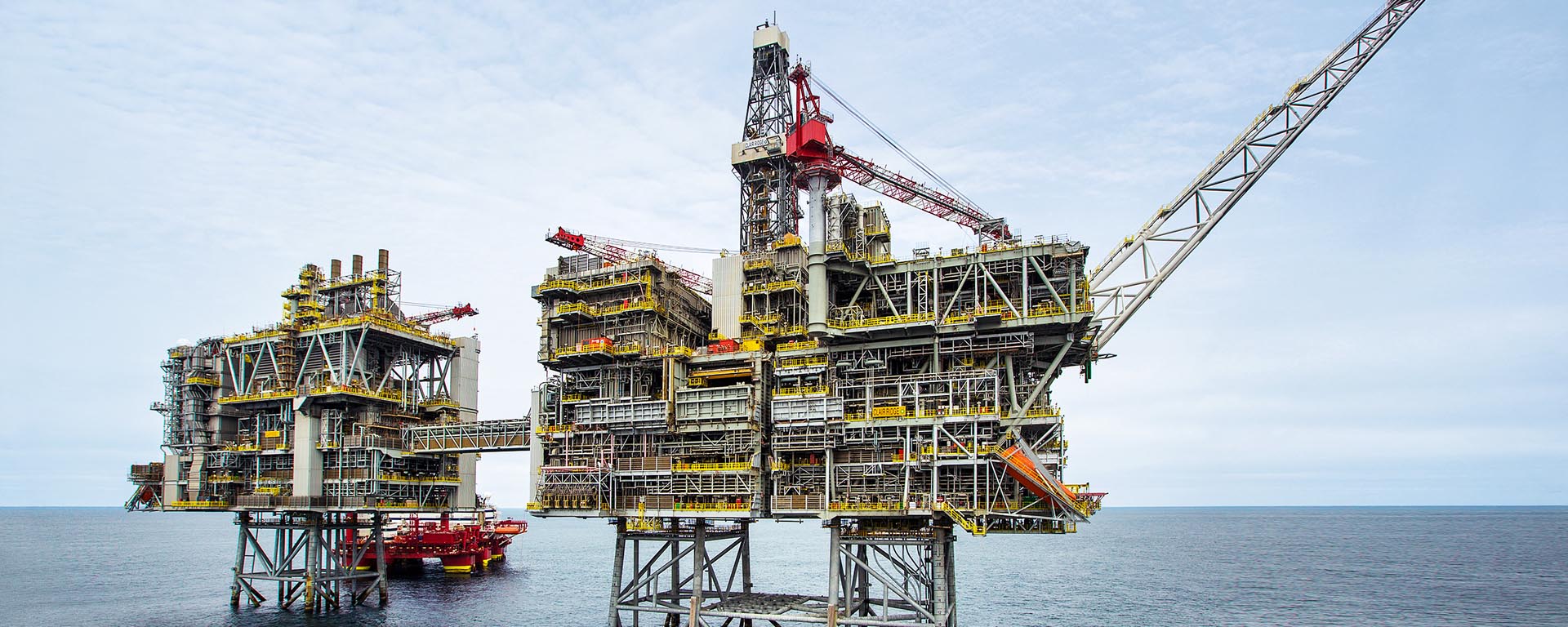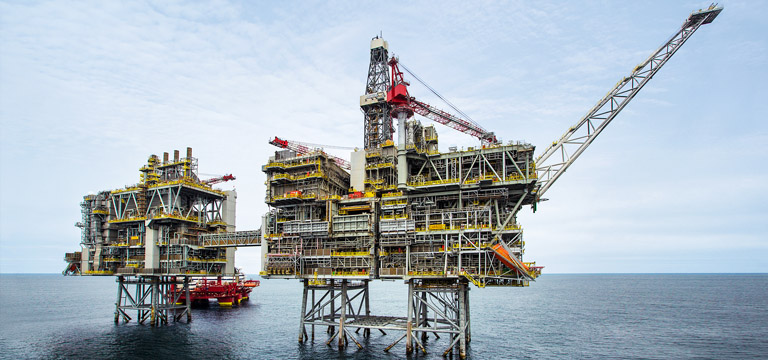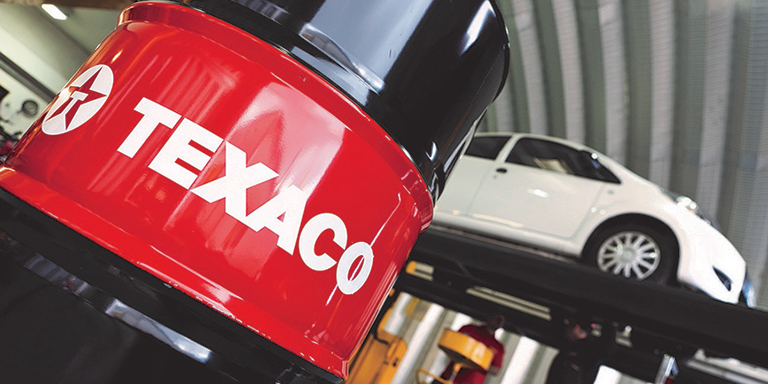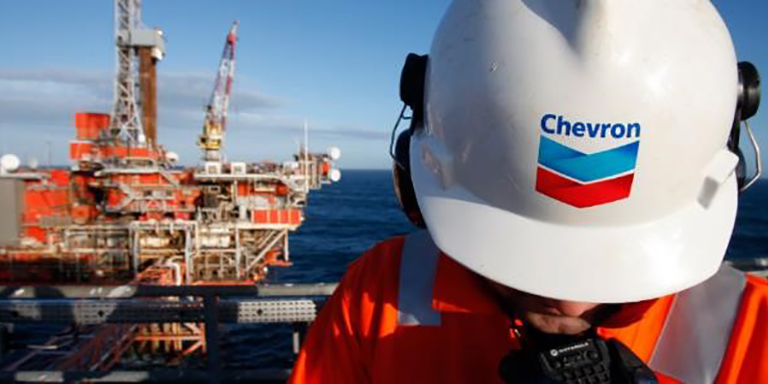

United Kingdom
partnering to deliver energy the U.K. needs
Chevron's presence in the U.K. North Sea spans more than 55 years.
Our business interests generate economic impacts at multiple levels across the U.K. economy and in many different ways, from capital investments, taxes, jobs, production and technology development, to supporting a world class supply chain and the global procurement of U.K. goods and services.
upstream activities
Through our subsidiary Chevron Britain Limited, we have a 19.4% nonoperated working interest in the Clair Field and associated assets.
The Clair field lies 47 miles (75 km) west of the Shetland Islands in the North Sea and extends over an area of 85 square miles (220 square km) in water depths of approximately 460 feet (140 m). Discovered in 1977, across Blocks 206/7a, 206/8, 206/9, 206/12 and 206/13a. Clair is one of the United Kingdom’s largest hydrocarbon resources. Oil and gas are exported via pipelines to the Sullom Voe Terminal on the Shetland Islands.
The Clair field is being developed using a phased approach. Clair Phase 1 was sanctioned in 2001 and was developed with a single fixed platform with production and processing facilities. First production was achieved in February 2005.
The second phase of development, the $10 billion Clair Ridge project, is designed to have a capacity of 120,000 barrels of crude oil and 100 million cubic feet of natural gas per day. The project was sanctioned in 2011 and in 2016 the construction and installation of two new bridge-linked platforms was completed. First oil was achieved in November 2018.
A six-well appraisal and exploration drilling program was conducted from 2013 into 2015.
Proved reserves have been recognized for the Clair Ridge project which is estimated to produce over 600 million barrels and has an estimated production life extending beyond 2050. Net daily oil-equivalent production in 2020 averaged 14,000 barrels. In 2024, net oil-equivalent production was 12,000 barrels per day, and daily net crude oil production was 11,000 barrels . Net natural gas production in 2024 was 7 million cubic feet per day.
The Windermere and MacCulloch Fields, which Chevron acquired in the 2020 purchase of Noble Energy, Inc., are being decommissioned.
at the center of technology
Chevron has a history of investing in technology, innovation and research and development in the U.K. Our continued investment supports the economic health of the U.K. through job creation, tax revenues, investments in the U.K. supply chain, research and development and the purchase of local goods and services.
Technology plays a critical role in meeting the challenges we face in the energy business. It has enabled Chevron to maximize resource recovery, improve operational efficiency, maximize reliability and production and develop new oil and gas reserves in deeper water and more complex formations.
Success depends on sustained collaboration across business segments and time zones. We leverage the ingenuity of our employees, suppliers and research partners to test and develop innovative new technologies that will help us meet energy needs and support economic growth around the world.
Our U.K. Global Technology Centre (GTC) was established in 2007. The GTC is a strategic extension of Chevron’s Energy Technology Company and complements Chevron’s existing technology facilities in Houston and Richmond in the United States; and Perth, Australia. It provides a hub of technical excellence that supports Chevron’s global portfolio of projects The U.K. GTC enables innovation and new technology deployments for a diverse range of Chevron operations and development projects, including Gorgon and Wheatstone in Australia, Tengizchevroil in Kazakhstan, and the Permian Basin in the United States.
As the digital transformation gathers pace, Chevron is focused on applying data science, predictive technologies, workflow automation and robotics to improve the safety and reliability of operations.
regional hub for global operations
From our London offices, we operate our exploration and production activities for Europe, Eurasia and the Middle East, European lubricants sales and marketing, and natural gas trading.

downstream and midstream
lubricants
London is the regional headquarters for Chevron’s Finished Lubricants operations in Europe, the Middle East and Africa. It is also a regional hub for the Chevron Marine Lubricants business providing support to marine lubricant activities globally.
Our Downstream business in the United Kingdom is conducted through our subsidiary Chevron Products UK Limited. Finished lubricants are sold under the Texaco® and Caltex® master brands in Europe, the Middle East and Africa respectively, along with product brands Havoline® for engine oils and coolants for passenger cars and vans, Delo® heavy duty engine oils and coolants and Techron fuel system cleaners across the region.
Our products are sold directly to customers or via our network of distributors. Find a distributor.
supply and trading
Chevron’s London office is home to one of the company’s four global trading floors, along with Houston, Texas; San Ramon, California; and Singapore. The Supply and Trading organization manages daily commodity transactions of 5 million barrels of liquids and 5 billion cubic feet of gas.
shipping
London is one of Chevron Shipping’s key regional offices. The London-based shipping team provides chartering, project management and marine assurance service to support Chevron business units throughout Europe and Africa. Additionally, shipping employees in Farnborough support marine logistics for the Tengizchevroil Future Growth Project - Wellhead Pressure Management Project (FGP-WPMP) in Kazakhstan. Chevron Shipping also operates a marine learning and development center in Glasgow.
chevron shipping opens marine learning and development center in Scotland
The Glasgow center is a state-of-the-art facility supported by some of the industry’s leading instructors, offering 30 training courses that cover navigation (bridge watchkeeping, basic ship handling, collision avoidance) to cargo handling (liquid and LNG) with technical areas including advanced hydraulics among others. The center also offers an operational and management leadership program, as well as various programs to help assess deck and engineering officers for promotion.

safety and environment
Operational Excellence (OE) puts into action The Chevron Way value of protecting people and the environment and helps us achieve Chevron’s vision to be the global energy company most admired for its people, partnership and performance.
In 2004, we launched our Operational Excellence Management System (OEMS), a comprehensive system that helped build our Operational Excellence (OE) culture and improve our health, environment and safety performance. Our recently updated OEMS features more visible linkages between risk, assurance and safeguards and contains a streamlined approach to manage risk. These updates help increase our focus on preventing high-consequence incidents and impacts.
the way we work
work with us
Through its investments in U.K. suppliers and contractors, Chevron helps foster local economic development and builds local supplier capacity to meet our business needs around the world.
Chevron is committed to providing full, fair and reasonable opportunity for U.K. industry to supply goods and services and works hard to ensure that opportunities for local suppliers and contractors are realised. We provide a yearly list of potential future contracting and supply opportunities through the Pilot Forward Workplan.
what we look for in suppliers
When sourcing high-quality goods and services, we value companies with the following qualities:
- Excellent safety record
- Demonstrable capability and deliverability
- Necessary compliance
- Cost efficiency
- Financial viability
- Competitive pricing
- Customer focus
- Innovative business, digital and technology solutions
- Working with our suppliers to promote safety
Excellent contractor safety is paramount to working with Chevron. To eliminate health, environment and safety incidents and injuries, we use a number of standardized work safety processes, including our Contractor Health Safety Management (CHESM) work process.
The CHESM work process helps to enhance the safety performance of third-party service suppliers and their subcontractors through conformance to Operational Excellence and ensures that Chevron works with the best contractors and service providers in the industry.
becoming a supplier
In support of the Oil & Gas UK Supply Chain Code of Practice, Chevron uses Achilles First Point Assessment (FPAL), the industry’s supply chain database. We encourage all current and prospective suppliers to ensure they are accurately and comprehensively registered on the FPAL database.
annual reports
Chevron Britain Limited Annual Report and Financial Statements 2023
Chevron Energy Limited Annual Report and Financial Statements 2023
Chevron Products UK Limited Annual Report and Financial Statements 2023
Chevron International Tankship Limited Annual Report and Financial Statements 2023
Chevron Tankers Limited Annual Report and Financial Statements 2023
Chevron International Exploration and Production Company Limited Annual Report 2023
Heddington Insurance UK Limited Annual Report 2023
Chevron Britain Limited Annual Report and Financial Statements 2022
Chevron Energy Limited Annual Report and Financial Statements 2022
Chevron Products UK Limited Annual Report and Financial Statements 2022
Chevron International Tankship Limited Annual Report and Financial Statements 2022
Chevron Tankers Limited Annual Report and Financial Statements 2022
Chevron International Exploration and Production Company Limited Annual Report 2022
Noble Energy (Oilex) Limited Annual Report and Financial Statements 2022
Heddington Insurance UK Limited Annual Report 2022
Chevron Britain Limited Annual Report and Financial Statements 2021
Chevron Energy Limited Annual Report and Financial Statements 2021
Chevron Global Trading Limited Annual Report and Financial Statements 2021
Chevron International Tankship Limited Annual Report and Financial Statements 2021
Chevron Products UK Limited Annual Report and Financial Statements 2021
Chevron Tankers Limited Annual Report and Financial Statements 2021
Heddington Insurance UK Limited Annual Report 2021
Chevron Britain Limited 2020 including Section 172 statement
Chevron Energy Limited 2020 including Section 172 statement
Chevron Eurasia Pacific Exploration and Production Company Limited 2020 including Section 172 statement
Chevron International Tankship Limited 2020 including Section 172 statement
Chevron Products UK Limited 2020 including Section 172 statement
Chevron Tankers Limited 2020 including Section 172 statement
Chevron Global Trading Limited 2020 including Section 172 statement
Heddington Insurance (UK) Limited 2020 including Section 172 statement
Chevron Britain Limited 2019 including Section 172 statement
Chevron Energy Limited 2019 including Section 172 statement
Chevron Eurasia Pacific Exploration and Production Company Limited 2019 including Section 172 statement
Chevron International Tankship Limited 2019 including Section 172 statement
Chevron Products UK Limited 2019 including Section 172 statement
Chevron Tankers Limited 2019 including Section 172 statement
Heddington Insurance (UK) Limited 2019 including Section 172 statement
contact information
Chevron Products UK Limited
1 Westferry Circus,
Canary Wharf,
London,
United Kingdom,
E14 4HA
Tel: +44 20 7719 3000
Registered in England and Wales
Registration No: 003600726
CAUTIONARY STATEMENTS RELEVANT TO FORWARD-LOOKING INFORMATION FOR THE PURPOSE OF “SAFE HARBOR” PROVISIONS OF THE PRIVATE SECURITIES LITIGATION REFORM ACT OF 1995 AND OTHER IMPORTANT LEGAL DISCLAIMERS
This website contains forward-looking images and statements relating to Chevron’s operations, assets, and strategy that are based on management's current expectations, estimates and projections about the petroleum, chemicals and other energy-related industries. Words or phrases such as “anticipates,” “expects,” “intends,” “plans,” “targets,” “advances,” “commits,” “drives,” “aims,” “forecasts,” “projects,” “believes,” “approaches,” “seeks,” “schedules,” “estimates,” “positions,” “pursues,” “progress,” "design," "enable," “may,” “can,” “could,” “should,” “will,” “budgets,” “outlook,” “trends,” “guidance,” “focus,” “on track,” "trajectory," “goals,” “objectives,” “strategies,” “opportunities,” “poised,” “potential,” “ambitions,” “future,” “aspires” and similar expressions, and variations or negatives of these words, are intended to identify such forward-looking statements, but not all forward-looking statements include such words. These statements are not guarantees of future performance and are subject to numerous risks, uncertainties and other factors, many of which are beyond the company’s control and are difficult to predict. Therefore, actual outcomes and results may differ materially from what is expressed or forecasted in such forward-looking statements. Our ability to achieve any aspiration, target or goal outlined on this website is subject to numerous risks, many of which are outside of our control. Examples of such risks include: (1) sufficient and substantial advances in technology, including the continuing progress of commercially viable technologies and low- or non-carbon-based energy sources; (2) laws, governmental regulation, policies, and other enabling actions, including those regarding subsidies, tax and other incentives as well as the granting of necessary permits by governing authorities; (3) the availability and acceptability of cost-effective, verifiable carbon credits; (4) the availability of suppliers that can meet our sustainability-related standards; (5) evolving regulatory requirements, including changes to IPCC’s Global Warming Potentials and the U.S. EPA Greenhouse Gas Reporting Program, affecting ESG standards or disclosures; (6) evolving standards for tracking and reporting on emissions and emissions reductions and removals; (7) customers’ and consumers’ preferences and use of the company’s products or substitute products; (8) actions taken by the company’s competitors in response to legislation and regulations; and (9) successful negotiations for carbon capture and storage and nature-based solutions with customers, suppliers, partners, and governments. Further, standards of measurement and performance set forth on this website made in reference to our environmental, social, governance, and other sustainability plans, goals and targets may be based on protocols, processes and assumptions that continue to evolve and are subject to change in the future, including due to the impact of future regulation. The reader should not place undue reliance on these forward-looking statements. Unless legally required, Chevron undertakes no obligation to update publicly any forward-looking statements, whether as a result of new information, future events or otherwise.
Among the important factors that could cause actual results to differ materially from those in the forward-looking statements are: changing crude oil and natural gas prices and demand for the company’s products, and production curtailments due to market conditions; crude oil production quotas or other actions that might be imposed by the Organization of Petroleum Exporting Countries and other producing countries; technological advancements; changes to government policies in the countries in which the company operates; public health crises, such as pandemics and epidemics, and any related government policies and actions; disruptions in the company’s global supply chain, including supply chain constraints and escalation of the cost of goods and services; changing economic, regulatory and political environments in the various countries in which the company operates; general domestic and international economic, market and political conditions, including the military conflict between Russia and Ukraine, the conflict in the Middle East and the global response to these hostilities; changing refining, marketing and chemicals margins; the company’s ability to realize anticipated cost savings and efficiencies associated with enterprise structural cost reduction initiatives; actions of competitors or regulators; timing of exploration expenses; changes in projected future cash flows; timing of crude oil liftings; uncertainties about the estimated quantities of crude oil, natural gas liquids and natural gas reserves; the competitiveness of alternate-energy sources or product substitutes; pace and scale of the development of large carbon capture and offset markets; the results of operations and financial condition of the company’s suppliers, vendors, partners and equity affiliates; the inability or failure of the company’s joint-venture partners to fund their share of operations and development activities; the potential failure to achieve expected net production from existing and future crude oil and natural gas development projects; potential delays in the development, construction or start-up of planned projects; the potential disruption or interruption of the company’s operations due to war, accidents, political events, civil unrest, severe weather, cyber threats, terrorist acts, or other natural or human causes beyond the company’s control; the potential liability for remedial actions or assessments under existing or future environmental regulations and litigation; significant operational, investment or product changes undertaken or required by existing or future environmental statutes and regulations, including international agreements and national or regional legislation and regulatory measures related to greenhouse gas emissions and climate change; the potential liability resulting from pending or future litigation; the risk that regulatory approvals and clearances related to the Hess Corporation (Hess) transaction are not obtained or are not obtained in a timely manner or are obtained subject to conditions that are not anticipated by the company and Hess; potential delays in consummating the Hess transaction, including as a result of the ongoing arbitration proceedings regarding preemptive rights in the Stabroek Block joint operating agreement; risks that such ongoing arbitration is not satisfactorily resolved and the potential transaction fails to be consummated; uncertainties as to whether the potential transaction, if consummated, will achieve its anticipated economic benefits, including as a result of risks associated with third party contracts containing material consent, anti-assignment, transfer or other provisions that may be related to the potential transaction that are not waived or otherwise satisfactorily resolved; the company’s ability to integrate Hess’ operations in a successful manner and in the expected time period; the possibility that any of the anticipated benefits and projected synergies of the potential transaction will not be realized or will not be realized within the expected time period; the company’s future acquisitions or dispositions of assets or shares or the delay or failure of such transactions to close based on required closing conditions; the potential for gains and losses from asset dispositions or impairments; government mandated sales, divestitures, recapitalizations, taxes and tax audits, tariffs, sanctions, changes in fiscal terms or restrictions on scope of company operations; foreign currency movements compared with the U.S. dollar; higher inflation and related impacts; material reductions in corporate liquidity and access to debt markets; changes to the company’s capital allocation strategies; the effects of changed accounting rules under generally accepted accounting principles promulgated by rule-setting bodies; the company’s ability to identify and mitigate the risks and hazards inherent in operating in the global energy industry; and the factors set forth under the heading “Risk Factors” on pages 20 through 27 of the company’s 2024 Annual Report on Form 10-K and in subsequent filings with the U.S. Securities and Exchange Commission. Other unpredictable or unknown factors not discussed on this website could also have material adverse effects on forward-looking statements.
For the latest figures, view the 2024 Supplement to the Annual Report.
